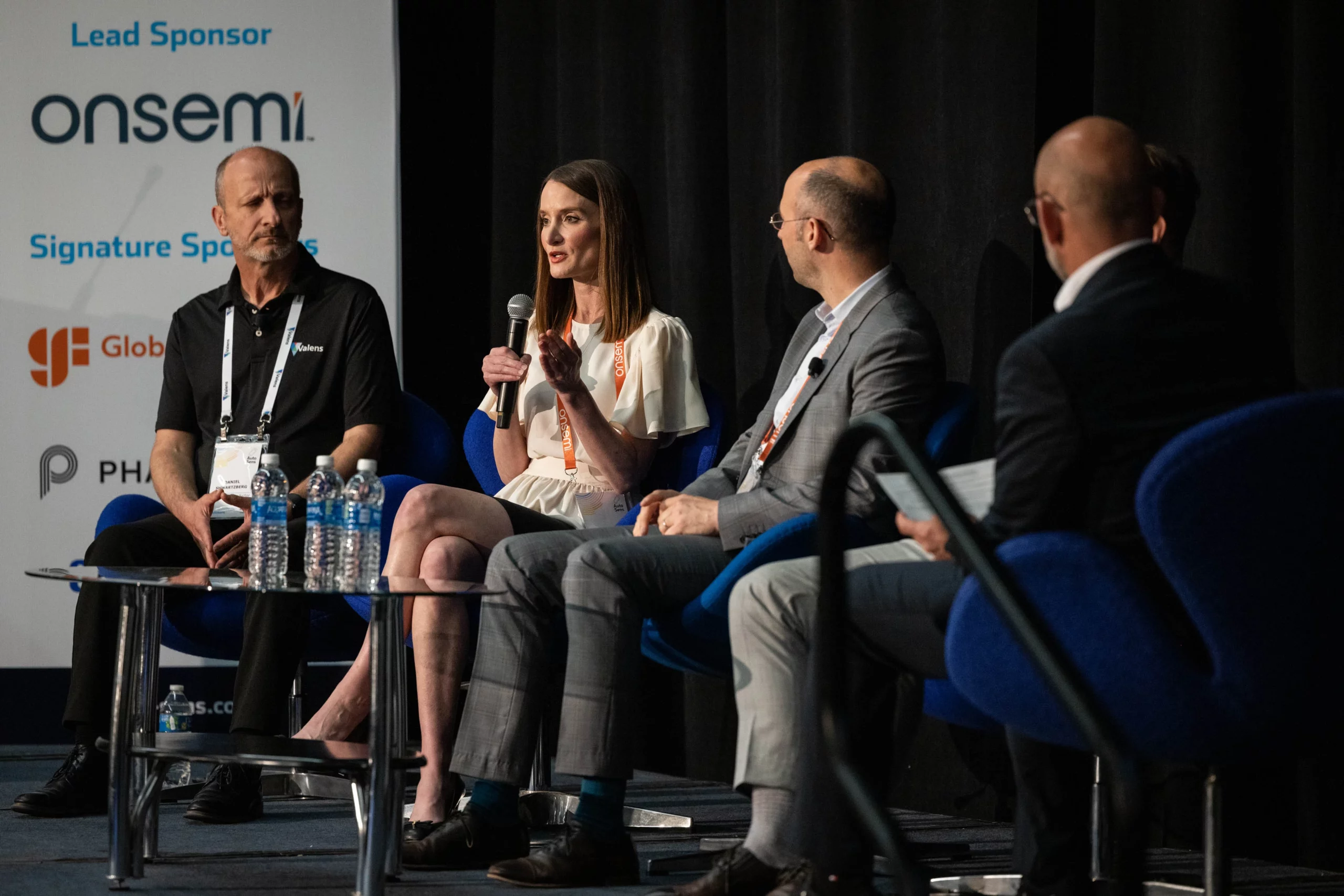08 – 10 OCTOBER 2024 | PALAU DE CONGRESSOS, BARCELONA
Expert content for engineers
AutoSens is the world’s most powerful community of professionals and engineers in ADAS and autonomous vehicles, working together to improve safety, shape regulations, and showcase innovation.
Schedule of Events
October 8th
- 10am - 5pm
Tutorials
- 10:30am - 4:30pm
Exhibitor Setup
- 4:30pm
Exhibition Opens
- 5:40pm - 7pm
Welcome Drinks Reception
October 9th
- 8:45am - 6pm
Conference & Exhibition
- 6:15pm - 8pm
Drinks Reception
October 10th
- 9am - 3:30pm
Conference & Exhibition
- 3:30pm - 5pm
Exhibitor Tear down
Key Themes
Relevant technical disciplines include image sensors, cameras, LiDAR, radar, thermal imaging, ultrasonic, image quality, optics, GPUs, IMUs, ethernet, sensor fusion, AI, computer vision, deep learning, algorithms, testing, calibration, validation, simulation, mapping, and localization.
This year’s Europe event will showcase innovations in all the above technology areas, and includes a focus on these Key Themes, defined via research with our engineering community:
Innovations and optimization in thermal imaging
Balancing AI and deterministic approaches for robust safety
Optimising EE architectures and data privacy
Leveraging mapping to improve safety
Improving visibility with better sensing, image quality and innovations in road infrastructure
Simulation and virtualization for design, testing, and validation
First Speaker Announced

Torsten Wendler
Head of Driving and ADAS / AD
Volkswagen China Tech. Co.
Leading projects and people across the automotive world of driver assistance for more than 15 years, Torsten holds a Master’s Degree in Mechanical Engineering from Technische Universität Braunschweig. He began work for Volkswagen AG in 2015 and relocated to China to join VW AnHui in 2019.

Also on the agenda...
- Market forces & Horizon Scanning
- Camera Technology
- Computer Vision
- Developments in LiDAR
- Windscreen Technology
- Data Simulation & Validation
- Deep Learning & Machine Learning
- Whole of Life Design – Environmental Responsibility/Materials
- Optics and Image Quality
- Park Assist and Low Speed Maneuvering
- Developments in RADAR
- Regulatory Updates
- Safety
- Standards & Evaluation
Innovation
What are the latest advancements in ADAS and AD technology, and who is driving change? Hear from OEMs, Tier 1s, and research institutes for an holistic industry overview.
Safety
Safety continues to be central to our discussions as we work towards a safer future for drivers, passengers and pedestrians; including a focus on data privacy, protection and cybersecurity.
Regulation
Ensuring vehicles comply with safety and privacy regulations continues to challenge the industry. AutoSens provides a platform to help shape these conversations.
Shaping Tomorrow's Automotive Sensing Landscape, One Discussion at a Time
In the heart of Detroit, where the automotive industry has been a driving force for innovation for over a century, the newly Co-Located conferences AutoSens & InCabin USA 2024 are set to take center stage from May 21st to May 23rd at the iconic Huntington Place.
Key focus areas for AutoSens include AI, V2X, data capture and simulation, and innovations in sensing technologies that are crucial for autonomous driving.


Technical Tutorials
Only available to Full Pass holders, our tutorials are the perfect opportunity to dive deep into core industry topics, interact with industry leaders, collaborate with like-minded engineers, and elevate your expertise by tackling tough questions and broadening your skill set.
Topics for 2024 include image quality, simulation and machine vision. Check out more details on the first three of our tutorials to be announced below.
Camera Image Quality Assessment for Automotive Perception Systems

Brian Deegan
Lecturer, Electrical & Electronic Engineering & Expert in Automotive Image Quality
University of Galway
To ensure safe operation of ADASx and autonomous driving features, including pedestrian detection, traffic sign recognition, lane departure warnings, and parking assistance, high-performance vision systems are essential. This tutorial covers the key elements of automotive camera image quality and its impact on machine vision and deep learning performance. We will explore the complete automotive imaging pipeline, from photon capture to object detection. Additionally, we will examine critical image quality metrics such as resolution, noise, dynamic range, and color accuracy, and discuss how these are defined and standardized by IEEE P2020 and other relevant image quality standards
Simulation Timing, Synchronization, and Determinism

Marius Dupuis
Owner
M. Dupuis Engineering Services
Choosing the setup for your simulation run plays a big role in getting timing, synchronization and determinism right. Especially in distributed environments with various modules running in parallel and at different frequencies, managing the sequence of execution is crucial. Characteristics that may or may not be combined are: synchronous vs asynchronous execution, real-time vs non real-time behavior, central timing vs individual timing, unified sampling rate vs multiple rates with sub-sampling etc.
Together, will dive a bit deeper into these aspects and try to figure out which influences different setups will have on your results and which combinations of the above-mentioned characteristics might be meaningful for your use cases. We will use rather simplistic programming examples (some even in pseudo-code) an concentrate mostly on understanding the underlying principles.
Information Metrics for Performance and Optimization of Machine Vision Systems

Norman Koren
CEO
Imatest
We discuss the mathematical background and practical measurement techniques for a new set of image quality metrics that promise to be superior to MTF (sharpness) and noise as predictors of machine vision performance. The new metrics include Noise Equivalent Quanta (NEQ), Ideal Observer SNR (SNRi), and Edge location standard deviation (Edge σ). They can be measured from slanted edges as well as Siemens star and dead leaves (spilled coins) test chart images.¬ We cover
- the origin and significance of information capacity, and its use as a fundamental metric for qualifying cameras,
- the effect on measurements of common types of image processing, especially the bilateral filters found in most JPEG images,
- the distinction between total information capacity and information capacity for contrast-limited patterns (typically 4:1 or 60% Michelson contrast slanted edges), which can be measured for a wide range of exposures,
- obtaining the metrics for object detection (SNRi) and the object location (Edge σ),
- the effects of sharpening and lowpass (noise-reduction) filtering, showing how excessive sharpening degrades performance,
- design of matched filters to optimize SNRi and Edge σ for specific tasks, and tradeoffs for multiple tasks
- progress in correlating the new metrics with standard machine vison performance metrics, such as Mean Average Precision (mAP) and Intersection over Union (IoU), which are related to object detection and location.
Industry Trends
-
The 'chiplets' trend
Impacts for hardware design, data processing, and system architecture.
-
Low speed automation
The latest sensor innovations for parking applications.
-
Supply chain dynamics
How you will be impacted by the changing ways companies are working together.
-
Robust and redundant sensing
How to make your sensing system bullet-proof.
Featured Presentations
Check out the first batch of expert-led sessions on our Agenda for AutoSens Europe.
Watch this space for more keynotes, presentations and panels to be announced soon.
KEYNOTE PRESENTATIONS
The Future of ADAS in China

Torsten Wendler
Head of ADAS/AD
Volkswagen Group (China) Technology Company
During the last few years China has been highly competitive in new energy vehicles market. Two fields of innovation stand out: Electrification and Advanced Driver Assistance Systems. To enhance competitiveness in China market, Volkswagen has established a comprehensive “in China for China” strategy. In the field of ADAS, the two core pillars are the launch of the “Volkswagen China Technology Company” and the foundation of a new joint venture with Horizon Robotics called “CARIZON”.
This keynote presentation will address the specific market situation in China for ADAS Systems, including features, trends, and regulations. It will cover Volkswagen’s insights and elaborate on the “in China for China” strategy and competence ramp-up. Additionally, Wendler will outline Volkswagen China Technology Company´s technology development strategy to better meet local demand and become the major foreign car manufacturer in China for NEVs.
The Major Flaw in Automotive Image Sensors

Albert Theuwissen
Founder
Harvest Imaging
Pixel Scaling in Automotive CMOS Image Sensors

Boyd Fowler
CTO
OMNIVISION
In mobile and security markets solid state image sensor pixels have been shrinking for the last 4 decades. Continuous efforts in this area have been driven by the need for increased spatial resolution and reduced systems costs. In the 1980s the average solid state image sensor pixels were larger than 10um x 10um, but by 2023 the smallest pixels used in mobile phone sensors were only 0.56um x 0.56um.
Although the automotive market has many similarities to the mobile and security markets it is very different. There is currently a push to reduce pixel size in automotive CMOS image sensors but the design tradeoffs make this a difficult task. In this presentation we will discuss the key tradeoffs associated with scaling pixels in CMOS images sensors for automotive applications. These performance tradeoffs include resolution, high dynamic range, signal to noise ratio (SNR), low light sensitivity, LED flicker mitigation, readout speed, power, die size and cost.
Optimising EE Architectures and Data Privacy
Connecting cameras in a futureproof EE architecture

Dr. Kirsten Matheus
Senior Expert
BMW AG
Balancing AI vs Deterministic Approaches for Robust Safety
How should Automated Vehicles be designed to ensure safe interactions between pedestrians and AVs?
Yee Mun Lee
Senior Research Fellow
Institute for Transport Studies
University of Leeds
In the future, Automated Vehicles (AVs) will need to interact with other road users, such as cyclists, pedestrians, and other vehicles. To enhance safety, improve traffic flow, and increase user acceptance and trust in AVs, pedestrians and other road users need to understand the AVs’ intentions, communication, and behaviour. We have conducted over ten experimental studies understanding P-AV interaction in our pedestrian lab at the University of Leeds. This presentation will provide an overview of what we have learnt, the key findings and our future directions.
Improving visibility with better sensing, image quality and innovations in road infrastructure
Camera Sensor Modelling – Technology, Use Cases and Challenges

Dr Martin Punke
Head of Camera Product Technology
Continental AG
Creating the right camera system for a global automotive Tier 1 supplier such as Continental involves various technical and commercial challenges, and camera sensor modelling is a key in helping to address these issues. In this presentation, we will delve into the technology behind camera sensor modelling and showcase its use in system architecture, development, and testing. Topics will include defining optical limits and camera resolution, deploying sensor models in computer vision CNN training and testing, and analyzing factors such as sharpness and motion blur and their impact on CV performance. As optoelectronic engineers with expertise in optics and image sensor technology, we focus on achieving optimal physical accuracy while ensuring the model’s integration into customer simulation frameworks.
We’ll highlight practical applications, such as optimizing system architecture by understanding MTF limits and addressing motion blur issues caused by longer sensor integration times. The session will conclude with a discussion on the ongoing challenges and advancements in camera sensor model development.
KEYNOTE PRESENTATIONS
What’s Driving Innovation? Regulation vs. Technology in the Global ADAS and AD Market

Roger C. Lanctot
Founder
Strategia Now
The automotive industry and regulators abhor a vacuum. It’s clear that regulators will not allow autonomy to simply “sneak up” on the industry and the market. China, the E.U., and even the U.S. are making their regulatory preferences known even though sometimes it may require reading tea leaves. Lanctot will read those tea leaves and describe how they are determining the pace of market adoption.
Accelerating the Adoption of In-Cabin Monitoring Systems

Adriano Palao
Technical Manager ADAS & AD
EuroNCAP
After the successful and pioneering introduction of Driver State Monitoring requirements in 2023 as part of the current 5 Star Programme, Euro NCAP will introduce in 2026 updated and new requirements in line with their Vision 2030 Roadmap, leveraging interior monitoring systems toward safe driving:
- Improved detection of seatbelt use
- Airbag & restraint optimization
- Direct child presence detection
- Post-crash information for Rescue
- Driver monitoring towards greater safety benefit & enhanced ADAS
Simulation and virtualization for design, testing, and validation
Addressing the Safety Challenge of L3 Autonomy with the Digital Twin

Conhas Thakkar
Solution Architect
Siemens
Quantifying Simulation Quality

Prof. Alexander Braun
Professor of Physics
University of Applied Sciences Dusseldorf
How good is the simulation you’re using to develop and test your ADAS/AD functionality? How realistic are the sensor models? How realistic do they have to be? How reproducible is your whole toolchain? How complete the testing of your simulations ODD?
These and related questions have been a relevant topic for the simulation practitioners in the automotive industry for at least the last 15-20 years. Now it’s time to come together to provide the framework with which to tackle the above challenges. Well-known standards body ASAM e.V. and Prof. Dr. Alexander Braun from University of Applied Sciences Düsseldorf have partnered to start the discussion about a standard for simulation quality, both on the very low level (physical-realistic sensor simulation) as well as the very high level (is your whole toolchain fit for purpose and reliable?). A first workshop / conference „Quantifying Simulation Quality“ has been (will have been) held in September in Düsseldorf where experts discussed the status quo in simulation quality and brainstormed: what should a standard about simulation quality look like?
In this talk Prof. Braun recaps the relevance of the topic, and highlights first findings and results from the QSQ conference in Düsseldorf.
From the sensor to a digital model and virtual testing

Lionel Bennes
Product Manager
AVxcelerate, Ansys

Andreas Lauinger
CEO
Kontrol GmbH
Advancements in sensor technologies and digital modeling have revolutionized the process of vehicle homologation, supporting the initiatives by KBA in of virtual homologation beeing part of the evidence to support a cost-effective and time-efficient alternative to traditional physical testing. Ansys and Kontrol explore the journey from real-world scenario acquisition to the creation of intricate digital models that accurately replicate real-world conditions to regulatory compliance testing.
It examines the integration of various sensing modalities such as LiDAR, radar, and cameras to test the full software stack, including sensor perception and fusion, that will ultimately define the vehicle behavior, performances, and safety in a digital testbed. Furthermore, it delves into the methodologies employed in capturing real-world scenario, replication, and exploration in simulation thanks to trustable physically accurate simulations. The benefits of virtual homologation are elucidated, including reduced development costs, accelerated time-to-market, and enhanced safety through iterative testing in diverse scenarios. Additionally, challenges such as data privacy concerns, model validation, and regulatory acceptance are addressed to provide a comprehensive understanding of the evolving landscape of virtual homologation.
Through a synthesis of recent research and industry trends, this presentation offers insights into the transformative potential of leveraging sensors and digital models in streamlining the homologation process, ultimately shaping the future of automotive regulatory compliance.
EXPERT PANEL DISCUSSIONS
PANEL SESSION
Session Title

Moderator
Name
Job Title
Company

Name
Job Title
Company

Name
Job Title
Company
PANEL SESSION
Session Title

Moderator
Name
Job Title
Company

Name
Job Title
Company

Name
Job Title
Company

Name
Job Title
Company
PANEL SESSION
Session Title

Moderator
Name
Job Title
Company

Name
Job Title
Company
Further panellists to be announced soon…
*Session titles and timings subject to change.
Also hear from...







